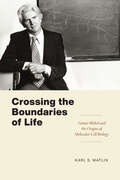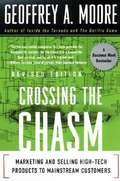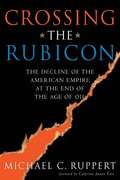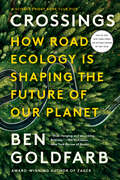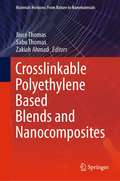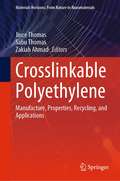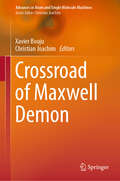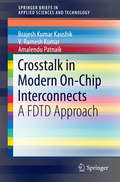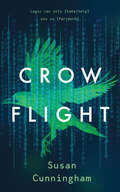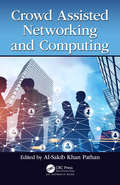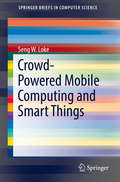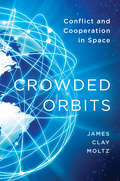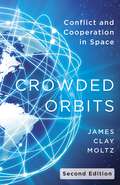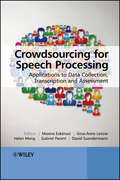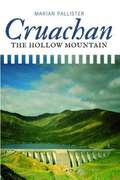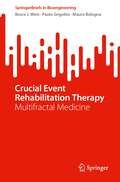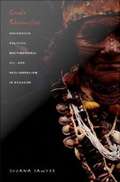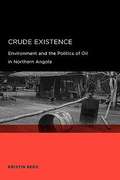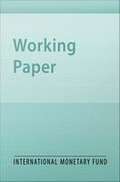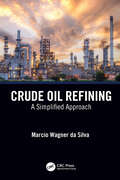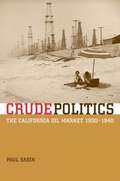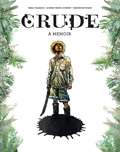- Table View
- List View
Crossing the Boundaries of Life: Günter Blobel and the Origins of Molecular Cell Biology (Convening Science: Discovery at the Marine Biological Laboratory)
by Karl S. MatlinA close look at Günter Blobel’s transformative contributions to molecular cell biology. The difficulty of reconciling chemical mechanisms with the functions of whole living systems has plagued biologists since the development of cell theory in the nineteenth century. As Karl S. Matlin argues in Crossing the Boundaries of Life, it is no coincidence that this longstanding knot of scientific inquiry was loosened most meaningfully by the work of a cell biologist, the Nobel laureate Günter Blobel. In 1975, using an experimental setup that did not contain any cells at all, Blobel was able to target newly made proteins to cell membrane vesicles, enabling him to theorize how proteins in the cell distribute spatially, an idea he called the signal hypothesis. Over the next twenty years, Blobel and other scientists were able to dissect this mechanism into its precise molecular details. For elaborating his signal concept into a process he termed membrane topogenesis—the idea that each protein in the cell is synthesized with an "address" that directs the protein to its correct destination within the cell—Blobel was awarded the Nobel Prize in Physiology or Medicine in 1999. Matlin argues that Blobel’s investigative strategy and its subsequent application addressed a fundamental unresolved dilemma that had bedeviled biology from its very beginning—the relationship between structure and function—allowing biology to achieve mechanistic molecular explanations of biological phenomena. Crossing the Boundaries of Life thus uses Blobel’s research and life story to shed light on the importance of cell biology for twentieth-century science, illustrating how it propelled the development of adjacent disciplines like biochemistry and molecular biology.
Crossing the Boundaries of Life: Günter Blobel and the Origins of Molecular Cell Biology (Convening Science: Discovery at the Marine Biological Laboratory)
by Karl S. MatlinA close look at Günter Blobel’s transformative contributions to molecular cell biology. The difficulty of reconciling chemical mechanisms with the functions of whole living systems has plagued biologists since the development of cell theory in the nineteenth century. As Karl S. Matlin argues in Crossing the Boundaries of Life, it is no coincidence that this longstanding knot of scientific inquiry was loosened most meaningfully by the work of a cell biologist, the Nobel laureate Günter Blobel. In 1975, using an experimental setup that did not contain any cells at all, Blobel was able to target newly made proteins to cell membrane vesicles, enabling him to theorize how proteins in the cell distribute spatially, an idea he called the signal hypothesis. Over the next twenty years, Blobel and other scientists were able to dissect this mechanism into its precise molecular details. For elaborating his signal concept into a process he termed membrane topogenesis—the idea that each protein in the cell is synthesized with an "address" that directs the protein to its correct destination within the cell—Blobel was awarded the Nobel Prize in Physiology or Medicine in 1999. Matlin argues that Blobel’s investigative strategy and its subsequent application addressed a fundamental unresolved dilemma that had bedeviled biology from its very beginning—the relationship between structure and function—allowing biology to achieve mechanistic molecular explanations of biological phenomena. Crossing the Boundaries of Life thus uses Blobel’s research and life story to shed light on the importance of cell biology for twentieth-century science, illustrating how it propelled the development of adjacent disciplines like biochemistry and molecular biology.
Crossing the Chasm: Marketing and Selling Disruptive Products to Mainstream Customers
by Geoffrey A. MooreHere is the bestselling guide that created a new game plan for marketing in high-tech industries. Crossing the Chasm has become the bible for bringing cutting-edge products to progressively larger markets. It provides new insights into the realities of high-tech marketing, with special emphasis on the Internet. It's essential reading for anyone with a stake in the world's most exciting marketplace.
Crossing the Digital Divide: Applying Technology to the Global Refugee Crisis
by Costello Culbertson Dimarogonas LannaAmid a growing global forced displacement crisis, refugees and the organizations that assist them have turned to technology as an important resource in solving problems in humanitarian settings. This report analyzes technology uses, needs, and gaps, as well as opportunities for better using technology to help displaced people and improving the operations of responding agencies.
Crossing the Rubicon
by Michael C RuppertThe Rubicon signifies a point of no return. Peak Oil and 9/11 are two such points that signal so profound a change in the course of world events that no one will remain unaffected. The attacks of September 11, 2001 were accomplished through an amazing orchestration of logistics and personnel. Crossing the Rubicon discovers and identifies key suspects - finding some of them in the highest echelons of American government - by showing how they acted in concert to guarantee that the attacks produced the desired result. A superbly detailed scrutiny of the events of 9/11, the book also ranges across the terrain of rapidly diminishing hydrocarbon energy supplies, geopolitics, narco-traffic, intelligence and militarism - without which 9/11 cannot be understood. Crafted as a criminal investigation of a homicide, Crossing the Rubicon examines: * the motives for the 9/11 attacks, including the Pentagon's need for a pretext for war that would enable an all-out drive for the planet's last reserves of oil and gas; Wall Street's need for liquid cash from restored traffic in Afghani heroin; and the administration's need for legal domestic repression during severe and imminent resource shortages; * the personnel, including Dick Cheney, the Pakistani Intelligence Agency (ISI), the Taliban, al Qaeda, the bin Ladens and elements of the government of Saudi Arabia: * the intelligence, including covert software, the full complexity of the US intelligence community, the connections with Wall Street and the Israeli government; * the carefully designed opportunity on the day of the attacks, the role of the Secret Service and the US Vice President: * the coverup; and * the outcome: "The War on Terror" as pretext for the loss of US civil liberties and domination of world oil reserves. ...at the end of three years of conducting a really independent investigation, Ruppert is not only heading in the right direction, but also touching the inner sanctum of the hidden government agenda. --Andreas von Bulow, former German Cabinet Minister & Parliamentary Secretary MICHAEL RUPPERT is the Publisher/Editor of From the Wilderness, a newsletter read by more than 16,000 subscribers in 40 countries. A former LAPD narcotics investigator, he is widely known for his groundbreaking stories on US involvement in the drug trade, Peak Oil and 9/11.
Crossings: How Road Ecology Is Shaping the Future of Our Planet
by Ben GoldfarbWinner of the Rachel Carson Award for Excellence in Environmental Journalism Finalist for the NYPL Helen Bernstein Book Award for Excellence in Journalism Finalist for the Reading the West Book Award in Nonfiction Finalist for the Colorado Book Award Named a Best Book of the Year by the New York Times, The New Yorker, Science News, Smithsonian Magazine, and Kirkus Reviews "A powerhouse of a book…comprehensive and engaging." —David Gessner, Washington Post An eye-opening account of the global ecological transformations wrought by roads, from the award-winning author of Eager. Some 40 million miles of roadways encircle the earth, yet we tend to regard them only as infrastructure for human convenience. While roads are so ubiquitous they’re practically invisible to us, wild animals experience them as entirely alien forces of death and disruption. In Crossings, environmental journalist Ben Goldfarb travels throughout the United States and around the world to investigate how roads have transformed our planet. A million animals are killed by cars each day in the U.S. alone, but as the new science of road ecology shows, the harms of highways extend far beyond roadkill. Creatures from antelope to salmon are losing their ability to migrate in search of food and mates; invasive plants hitch rides in tire treads; road salt contaminates lakes and rivers; and the very noise of traffic chases songbirds from vast swaths of habitat. Yet road ecologists are also seeking to blunt the destruction through innovative solutions. Goldfarb meets with conservationists building bridges for California’s mountain lions and tunnels for English toads, engineers deconstructing the labyrinth of logging roads that web national forests, animal rehabbers caring for Tasmania’s car-orphaned wallabies, and community organizers working to undo the havoc highways have wreaked upon American cities. Today, as our planet’s road network continues to grow exponentially, the science of road ecology has become increasingly vital. Written with passion and curiosity, Crossings is a sweeping, spirited, and timely investigation into how humans have altered the natural world—and how we can create a better future for all living beings.
Crosslinkable Polyethylene Based Blends and Nanocomposites (Materials Horizons: From Nature to Nanomaterials)
by Sabu Thomas Jince Thomas Zakiah AhmadThis volume serves as a cutting edge reference on XLPE based blends, nanocomposites, and their applications. The book provides an introduction to XLPE nanocomposites and discusses the incorporation of natural and inorganic nanoparticles in the XLPE matrix. It also focuses on its characterization as well as the morphological, rheological, mechanical, viscoelastic, thermal, and electrical, properties. It provides an in-depth review of various potential applications, with special emphasis on use in cable insulation. The book focuses on cutting edge research developments, looking at published papers, patents, and production data. This book will be of use to academic and industry researchers, as well as graduate students working in the fields of polymer science and engineering, materials science, and chemical engineering.
Crosslinkable Polyethylene: Manufacture, Properties, Recycling, and Applications (Materials Horizons: From Nature to Nanomaterials)
by Sabu Thomas Jince Thomas Zakiah AhmadThis volume covers various aspects of cross-linked polyethylene (XLPE). The contents include manufacture, morphology, structure, properties, applications, early stage development, cross-linking techniques, recycling process, physical and chemical properties as well as the scope and future aspects of XLPE. It focuses on the life cycle analysis of XLPE and their industrial applications and commercial importance. This book will be of use to academic and industry researchers, as well as graduate students working in the fields of polymer science and engineering, materials science, and chemical engineering.
Crossroad of Maxwell Demon (Advances in Atom and Single Molecule Machines)
by Christian Joachim Xavier BoujuWritten by leading experts in this field, this proceedings volume originates from a workshop held in Toulouse on March 1–2, 2023, organized by the ESIM European project (Energy Storage Inside Molecule(s)). The book explores the intersection and convergence of various perspectives, disciplines, and research areas related to a modern version of the Maxwell demon at the nanoscale. It presents interdisciplinary perspectives on topics such as intramolecular thermodynamics and single molecule motive power and overviews the realm of single objects, be it atoms or molecules, while also emphasizing on theoretical and experimental approaches, with or without the presence of supporting surfaces. Notably, this comprehensive collection represents the first instance where such intertwined contributions on diverse versions of the Maxwell demon are discussed within the context of the nanoscale. It is of great use to graduate students, postdoctoral fellows, and researchers who are interested in single molecule mechanics.
Crosstalk in Modern On-Chip Interconnects: A FDTD Approach (SpringerBriefs in Applied Sciences and Technology)
by Brajesh Kumar Kaushik V. Ramesh Kumar Amalendu PatnaikThe book provides accurate FDTDmodels for on-chip interconnects, covering most recent advancements inmaterials and design. Furthermore, depending on the geometry and physicalconfigurations, different electrical equivalent models for CNT and GNR basedinterconnects are presented. Based on the electrical equivalent models theperformance comparison among the Cu, CNT and GNR-based interconnects are alsodiscussed in the book. The proposed models are validated with the HSPICEsimulations. The book introduces the currentresearch scenario in the modeling of on-chip interconnects. It presents thestructure, properties, and characteristics of graphene based on-chipinterconnects and the FDTD modeling of Cu based on-chip interconnects. Themodel considers the non-linear effects of CMOS driver as well as thetransmission line effects of interconnect line that includes couplingcapacitance and mutual inductance effects. In a more realistic manner, theproposed model includes the effect of width-dependent MFP of the MLGNR whiletaking into account the edge roughness.
Crow Flight
by Susan CunninghamThe curious flight patterns of crows lead a teen computer programmer down a path of mystery and romance.Gin trusts logic a little too much. She even designs programs to decide what to eat and how to spend her time. All that changes when she's paired with a new transfer student, Felix, on a computer modeling assignment to explain certain anomalies in the behavior of crows.Speaking of anomalies, why is Gin so disappointed that Felix isn't a match for her in the dating app she's designing with local gamers?As she enters Felix's world and digs further into the data behind crow behavior, Gin uncovers a terrible secret. And the wrong decision could equal disaster squared...
Crowd Assisted Networking and Computing
by Al-Sakib Khan PathanCrowd computing, crowdsourcing, crowd-associated network (CrAN), crowd-assisted sensing are some examples of crowd-based concepts that harness the power of people on the web or connected via web-like infrastructure to do tasks that are often difficult for individual users or computers to do alone. This creates many challenging issues like assessing reliability and correctness of crowd generated information, delivery of data and information via crowd, middleware for supporting crowdsourcing and crowd computing tasks, crowd associated networking and its security, Quality of Information (QoI) issues, etc. This book compiles the latest advances in the relevant fields.
Crowd Funding for Filmmakers: The Way to a Successful Film Campaign
by John T. TrigonisThis book offers practical information, tips, and tactics for launching a successful film campaign by detailing traditional models of fundraising, utilizing today’s technological and social innovations, and augmenting each step with an added personal touch. This 2nd edition updates the latest techniques on Social Media to get your projects up and running asap.
Crowd-Powered Mobile Computing and Smart Things
by Seng W. LokeThis SpringerBrief provides a synergistic overview of technology trends by emphasizing five linked perspectives: crowd+cloud machines, extreme cooperation with smart things, scalable context-awareness, drone services for mobile crowds and social links in mobile crowds. The authors also highlight issues and challenges at the intersection of these trends. Topics covered include cloud computing, Internet of Things, mobile and wearable computing, crowd computing, the culture of thing sharing, collective computing, and swarm dynamics. The brief is a useful resource and a starting point for researchers, students or anyone interested in the contemporary computing landscape.
Crowded Orbits: Conflict and Cooperation in Space
by James Clay MoltzSpace has become increasingly crowded since the end of the Cold War, with new countries, companies, and even private citizens operating satellites and becoming spacefarers. This book offers general readers a valuable primer on space policy from an international perspective. It examines the competing themes of space competition and cooperation while providing readers with an understanding of the basics of space technology, diplomacy, commerce, science, and military applications. The recent expansion of human space activity poses new challenges to existing treaties and other governance tools for space, increasing the likelihood of conflict over a diminishing pool of beneficial locations and resources close to Earth. Drawing on more than twenty years of experience in international space policy debates, James Clay Moltz examines possible avenues for cooperation among the growing pool of space actors, considering their shared interests in space traffic management, orbital debris control, division of the radio frequency spectrum, and the prevention of military conflict. Moltz concludes with policy recommendations for enhanced international collaboration in space situational awareness, scientific exploration, and restraining harmful military activities.
Crowded Orbits: Conflict and Cooperation in Space
by James Clay MoltzSpace has become increasingly crowded since the turn of the century, as a growing number of countries, companies, and even private citizens have begun operating satellites and become spacefarers. Crowded Orbits offers readers a valuable primer on space policy from an international perspective, examining technology, diplomacy, commerce, science, and military applications. This second edition is thoroughly updated to cover events of the decade following the book’s original publication in 2014, when the pace of the competition to exploit space has accelerated dramatically.James Clay Moltz examines the ongoing tension between competition and cooperation in space, tracing the geopolitical and policy consequences of key developments. Drawing on decades of experience, he considers possible avenues for collaboration among the growing number of actors as well as the forces driving potential space-related conflicts. Moltz examines the challenges to existing treaties and other governance mechanisms that have struggled to keep up with the spread of technology. He provides policy recommendations to enhance international collaboration, further scientific exploration, and restrain harmful military activities. This edition features analysis of a range of topics, including the ongoing commercialization of space by SpaceX, Planet, and other start-up companies; new capabilities to monitor Earth from space; renewed tensions between the United States and rivals China and Russia in military activities; and emerging multinational competition on the Moon.
Crowdsourcing for Speech Processing: Applications to Data Collection, Transcription and Assessment
by David Suendermann Gina-Anne Levow Gabriel Parent Maxine Eskenazi Helen MengProvides an insightful and practical introduction to crowdsourcing as a means of rapidly processing speech data Intended for those who want to get started in the domain and learn how to set up a task, what interfaces are available, how to assess the work, etc. as well as for those who already have used crowdsourcing and want to create better tasks and obtain better assessments of the work of the crowd. It will include screenshots to show examples of good and poor interfaces; examples of case studies in speech processing tasks, going through the task creation process, reviewing options in the interface, in the choice of medium (MTurk or other) and explaining choices, etc. Provides an insightful and practical introduction to crowdsourcing as a means of rapidly processing speech data. Addresses important aspects of this new technique that should be mastered before attempting a crowdsourcing application. Offers speech researchers the hope that they can spend much less time dealing with the data gathering/annotation bottleneck, leaving them to focus on the scientific issues. Readers will directly benefit from the book’s successful examples of how crowd- sourcing was implemented for speech processing, discussions of interface and processing choices that worked and choices that didn’t, and guidelines on how to play and record speech over the internet, how to design tasks, and how to assess workers. Essential reading for researchers and practitioners in speech research groups involved in speech processing
Cruachan: The Hollow Mountain
by Marian PallisterA history of the Scottish power station constructed inside Ben Cruachan beginning in 1959, and its effect on the nearby community. &“Cruachan!&” was the battle cry of the Campbells. In the early 1960s, the invasion of the 3,000 men who hollowed out Argyll&’s noblest and highest mountain as part of a massive hydroelectric project could have annihilated the local community. Instead, the people of Loch Awe, Dalmally, and Taynuilt welcomed the invaders, embraced the project and emerged the winners. Fifty years on, an integrated community still lives under the Hollow Mountain, and the cry &“Cruachan!&” signifies a Scottish success story. In this book, based on interviews, media reports, court reports, and film archive material, Marian Pallister tells the story of the project—featuring the extraordinary experience of those who worked on the mountain as well as the effects on the local community of one of the biggest civil engineering projects ever to have been undertaken in Scotland. She also considers the long-term effects of the project, looking at how the community was changed by the experience.
Crucial Event Rehabilitation Therapy: Multifractal Medicine (SpringerBriefs in Bioengineering)
by Mauro Bologna Bruce J. West Paolo GrigoliniThis book describes a new strategy for rehabilitation from injury and/or disease using Crucial Event Therapy. Recent studies have shown that individuals can recuperate more rapidly from surgery and other invasive procedures intended to correct the negative effects of disease or injury through the use of life support systems that operate at the body's natural biofrequencies. The same observation has been clinically shown to reverse the degenerative effects of neurodegenerative diseases such as Parkinson’s and Alzheimer's Disease. Crucial Event Therapy describes medicine as the operational control of the functions of the human body treated as a network-of-networks, with 1/f-variable crucial events coding the dynamic states of health and disease through information flow within a network and information exchange between biomedical networks. A new way of thinking based on the statistics of Cortical Events is presented and the relevant literature is suitably referenced. This is an ideal book for biophysicists and data scientists seeking to understand the connection of complexity measures for the study of consciousness with the clinical aspects of designing a rehabilitation strategy.
Crude Chronicles: Indigenous Politics, Multinational Oil, and Neoliberalism in Ecuador
by Suzana SawyerEcuador is the third-largest foreign supplier of crude oil to the western United States. As the source of this oil, the Ecuadorian Amazon has borne the far-reaching social and environmental consequences of a growing U. S. demand for petroleum and the dynamics of economic globalization it necessitates. Crude Chronicles traces the emergence during the 1990s of a highly organized indigenous movement and its struggles against a U. S. oil company and Ecuadorian neoliberal policies. Against the backdrop of mounting government attempts to privatize and liberalize the national economy, Suzana Sawyer shows how neoliberal reforms in Ecuador led to a crisis of governance, accountability, and representation that spurred one of twentieth-century Latin America's strongest indigenous movements. Through her rich ethnography of indigenous marches, demonstrations, occupations, and negotiations, Sawyer tracks the growing sophistication of indigenous politics as Indians subverted, re-deployed, and, at times, capitulated to the dictates and desires of a transnational neoliberal logic. At the same time, she follows the multiple maneuvers and discourses that the multinational corporation and the Ecuadorian state used to circumscribe and contain indigenous opposition. Ultimately, Sawyer reveals that indigenous struggles over land and oil operations in Ecuador were as much about reconfiguring national and transnational inequality--that is, rupturing the silence around racial injustice, exacting spaces of accountability, and rewriting narratives of national belonging--as they were about the material use and extraction of rain-forest resources.
Crude Existence: Environment and the Politics of Oil in Northern Angola
by Kristin ReedAfter decades of civil war and instability, the African country of Angola is experiencing an economic boom thanks to its most valuable natural resource: oil. Focusing on the everyday realities of people living in the extraction zones, this work explores the exclusion, degradation and violence that are the fruits of petrocapitalism in Angola.
Crude Oil Prices: Trends and Forecast
by Noureddine KricheneA report from the International Monetary Fund.
Crude Oil Refining: A Simplified Approach
by Marcio Wagner da SilvaThis book provides an overview of crude oil refining processes and presents a deep analysis of the current context and challenges imposed on players in the downstream industry. Crude Oil Refining: A Simplified Approach covers traditional processes of the refining industry, the impact of current trends, and technological routes available to help these players survive in a highly competitive environment. FEATURES Offers a simplified approach to crude oil refining processes Discusses economic information related to the downstream business, including refining margins and profitability Introduces newer trends in the industry, such as petrochemical integration, crude-to-chemicals refineries, and renewables coprocessing in crude oil refineries Presents the challenges related to these new trends and offers technological solutions to overcome them for profitable and sustainable operations Describes how the use of biofuels can minimize the environmental impact of transportation fuel in nations of high demand like Brazil Offering a contemporary view of current challenges and opportunities in the downstream oil and gas business, this practical book is aimed at readers working in the fields of petroleum and chemical engineering.
Crude Politics: The California Oil Market, 1900-1940
by Paul SabinSabin challenges us to see politics and law as crucial forces behind the dramatic growth of the U.S. oil market during the twentieth century.
Crude: A Memoir
by Pablo Fajardo Sophie Tardy-JoubertOil waste was everywhere—on the roads, in the rivers where they fished, and in the water that they used for bathing, cooking, and washing. Children became sick and died, cases of stomach cancer skyrocketed, and women miscarried or gave birth to children with congenital disorders. The American oil company Texaco—now part of Chevron—extracted its first barrel of crude oil from Amazonian Ecuador in 1972. It left behind millions of gallons of spilled oil and more than eighteen million gallons of toxic waste. In Crude, Ecuadorian lawyer and activist Pablo Fajardo gives a firsthand account of Texaco’s involvement in the Amazon as well as the ensuing legal battles between the oil company, the Ecuadorian government, and the region’s inhabitants. As a teenager, Fajardo worked in the Amazonian oil fields, where he witnessed the consequences of Texaco/Chevron’s indifference to the environment and to the inhabitants of the Amazon. Fajardo mobilized with his peers to seek reparations and in time became the lead counsel for UDAPT (Union of People Affected by Texaco), a group of more than thirty thousand small farmers and indigenous people from the northern Ecuadorian Amazon who continue to fight for reparations and remediation to this day.Eye-opening and galvanizing, Crude brings to light one of the least well-known but most important cases of environmental and racial injustice of our time.
